Germany Rigid Plastic Packaging Market Size
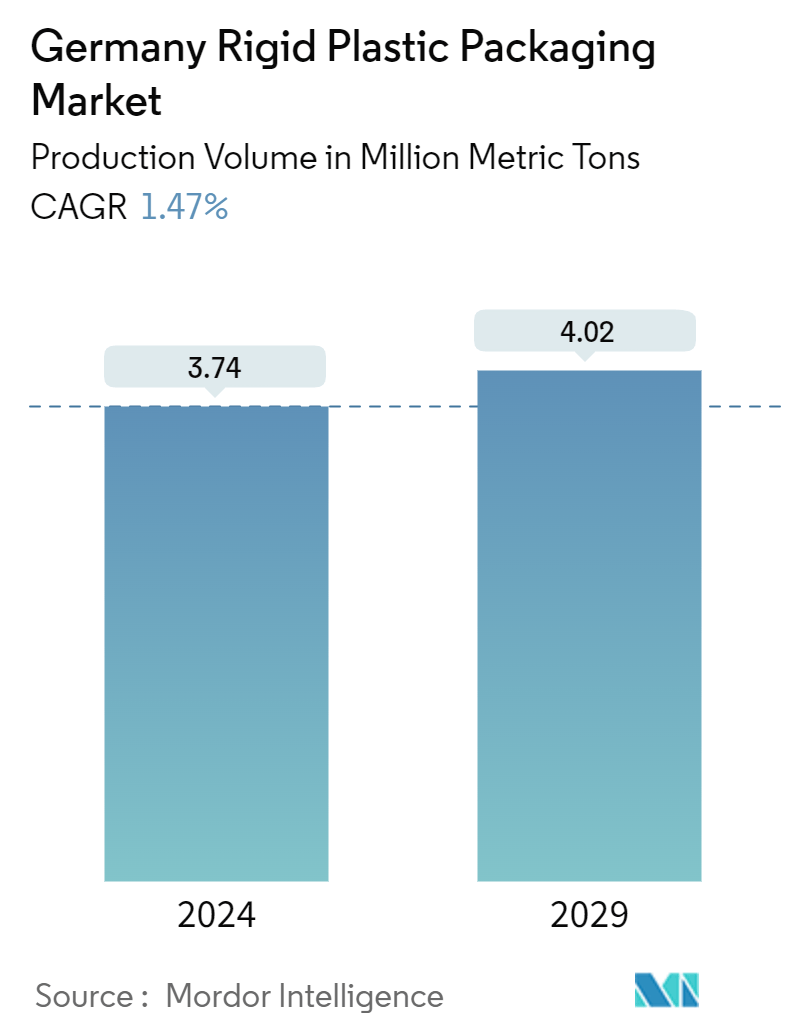
| Study Period | 2019 - 2029 |
| Base Year For Estimation | 2023 |
| Forecast Data Period | 2024 - 2029 |
| Historical Data Period | 2019 - 2022 |
| CAGR (2024 - 2029) | 1.47 % |
| Market Concentration | Medium |
Major Players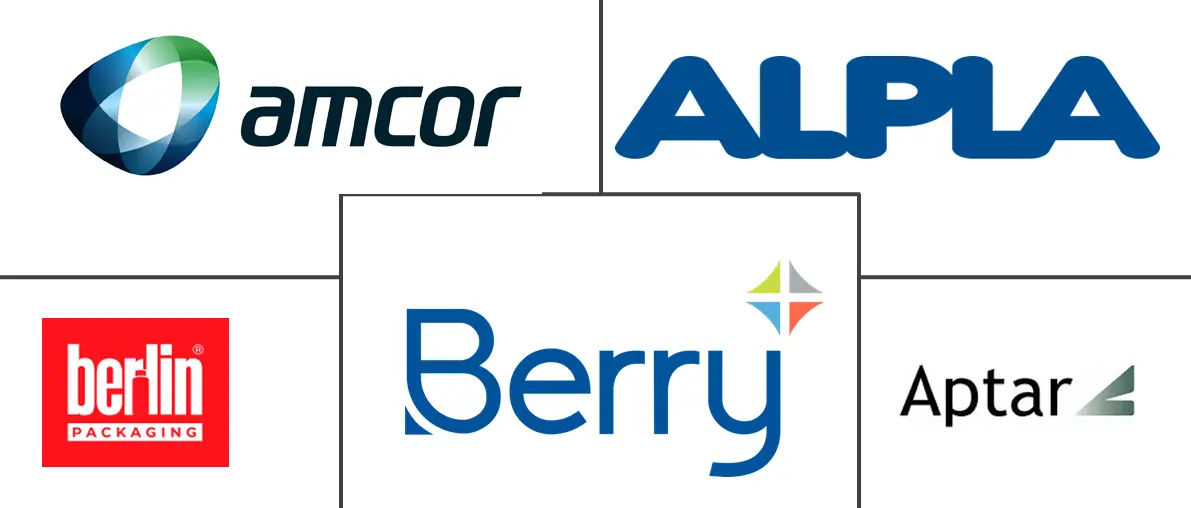
*Disclaimer: Major Players sorted in no particular order |
Germany Rigid Plastic Packaging Market Analysis
The Germany Rigid Plastic Packaging Market size in terms of production volume is expected to grow from 3.74 Million metric tons in 2024 to 4.02 Million metric tons by 2029, at a CAGR of 1.47% during the forecast period (2024-2029).
- Germany's rigid plastic packaging landscape is diverse and dynamic, applicable to a wide range of industries. Rigid plastic packaging products include bottles, containers, trays, tubs, IBCS, crates, and pallets, which are extensively used across various sectors, such as food and beverages, pharmaceuticals, personal care, and household products. These packaging solutions offer durability, protection, and convenience, making them a preferred choice for many end users.
- Rigid plastic packaging can be categorized into primary, secondary, and tertiary. Primary packaging directly contacts the product, such as beverage bottles and food items containers. Secondary packaging groups primary packages together, like crates of beverage bottles. Tertiary packaging, including crates and pallets, is used for bulk handling and shipping.
- The materials used in rigid plastic packaging vary, with common options including polyethylene terephthalate (PET), high-density polyethylene (HDPE), polypropylene (PP), and polystyrene (PS). Each material offers unique properties that make it suitable for specific applications. For instance, PET is widely used for beverage bottles due to its clarity and strength. At the same time, HDPE is favored for household and industrial chemical containers because of its resistance to impact and chemicals.
- Rigid plastic packaging ensures the safety and freshness of products, extending shelf life and reducing food waste in the food and beverage industry. Pharmaceutical companies use these packaging solutions to protect sensitive medications from contamination and damage. Personal care products, including shampoos and lotions, rely on the aesthetic appeal and functionality of rigid plastic packaging, which enhances brand visibility and consumer convenience.
- Household products, including cleaning agents and detergents, also utilize rigid plastic packaging for its robustness and ease of use. The versatility and adaptability of rigid plastic packaging materials make them indispensable across these varied end-user industries, driving continuous innovation and development.
- Plastics Europe reported that in 2023, the German plastics manufacturing industry faced its second consecutive year of significant decline, driven by high energy prices, rising labor costs, and escalating production expenses. In 2023, sales plummeted by 21.9%, and demand for plastics in Germany saw a 16% drop. The plastics value chain aims to implement crucial strategic and structural changes to emerge more robustly from this crisis. The German and European plastics sectors boast a technological edge over their global counterparts, especially in producing plastics from non-fossil raw materials. To sustain and amplify this advantage, it is vital to channel investments into innovative technologies, including enhancing mechanical and chemical recycling processes and exploring alternative hydrocarbon sources.
Germany Rigid Plastic Packaging Market Trends
Industrial Sector Drives Demand For Rigid Plastic Packaging Products
- Germany stands as a global industrial powerhouse. Renowned for its expertise, German firms specialize in crafting intricate goods, with a particular emphasis on capital goods and cutting-edge production technologies. The country's prowess in innovation is widely recognized as the cornerstone of its economic might. Major economic activities are concentrated in bustling metropolitan hubs, notably the Ruhr region. Munich and Stuttgart shine in high-tech and automotive manufacturing, while the Rhine-Neckar area is a chemical industry hotspot.
- Rising energy prices and interest rates have escalated costs, stifling investments in an already beleaguered manufacturing sector, contending with supply chain challenges. Following a downturn in 2023, German industrial production is poised to lag even further this year. The typically robust manufacturing landscape has already been bruised by surging energy costs.
- This entrenched manufacturing base fuels a significant appetite for rigid plastic packaging solutions. From raw materials to finished products, plastic drums, and intermediate bulk containers play a pivotal role in storage and transportation, catering to both liquids and solid powders. Once products are complete, plastic pallets facilitate easy handling during storage, and plastic crates serve both distribution and storage needs.
- In 2023, Germany ranked as the world's third-largest petrochemical seller, achieving sales exceeding EUR 82.4 billion (equivalent to USD 91.44 billion). This significant market position is expected to drive demand for rigid plastic packaging products in Germany, as petrochemicals are a key raw material in their production. The robust sales figures indicate a strong supply chain and availability of materials, which could lead to increased production and innovation in the rigid plastic packaging sector. The thriving petrochemical industry also fosters advancements in manufacturing processes and material quality, enhancing the overall competitiveness of Germany's rigid plastic packaging market. Additionally, the strong petrochemical industry helps drive demand for Intermediate Bulk Containers (IBCs) and rigid plastic pallets, further supporting the growth of the packaging market.
- In July 2023, CHEP, a leader in pallet pooling and sustainable supply chain solutions, unveiled its innovative quarter display pallet, Q+. This new iteration marks the first-ever pallet made entirely from post-consumer plastic waste, highlighting a significant leap in regenerative promotions at the point of sale. Embracing circularity in product design, CHEP introduced a product that showcases innovation and tackles the pressing issue of plastic waste. Initially launched three decades ago in Germany, the quarter pallet has since made its way into major EU countries and the United Kingdom. It is currently adopted by all leading European retailers.
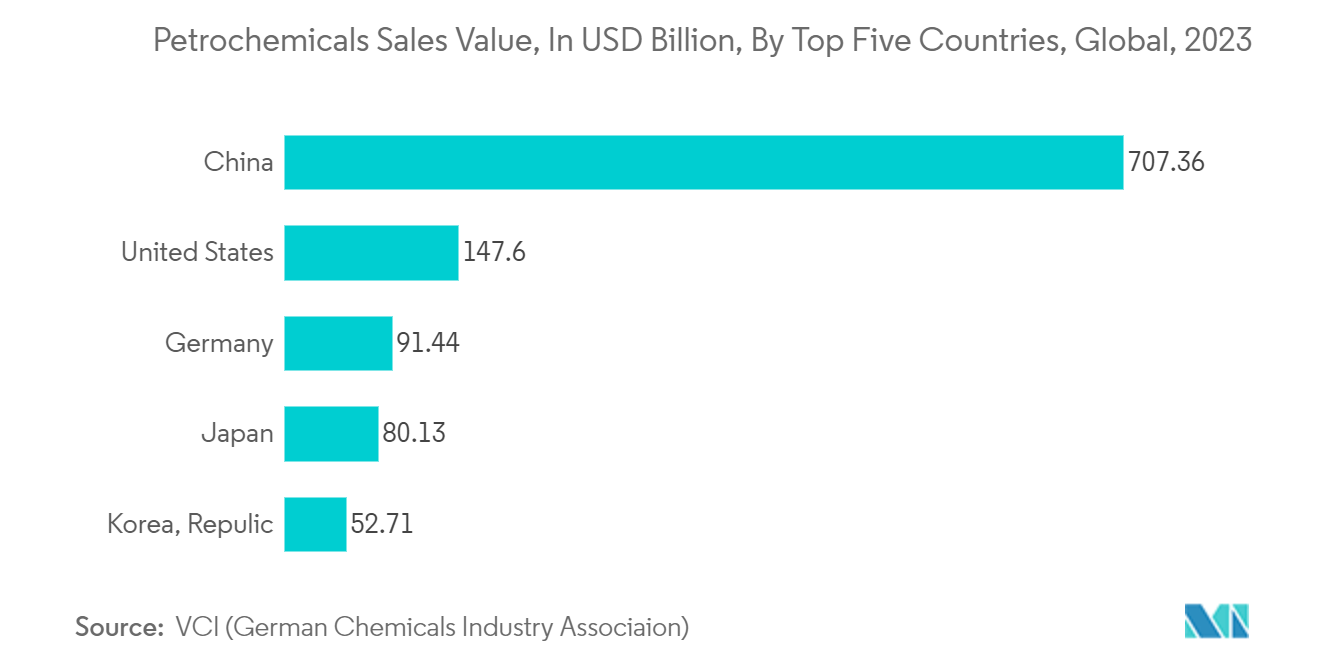
Food and Beverage Sector is Set to Witness Significant Growth
- As reported by Germany Trade and Invest (GTA), Germany's food and beverage sector ranks as the fourth-largest industry in the country. Germany's food and beverage market has grown significantly over the years, driven by a strong economy and high consumer demand. This sector includes a variety of products, from dairy and meat to beverages and confectionery, catering to both domestic and international markets. The industry's robust infrastructure and advanced technology contribute to its leading position in Europe.
- Rigid plastic packaging is crucial for the food and beverage market in Germany. It ensures the safety and longevity of products, maintaining their quality from production to consumption. This type of packaging is particularly popular for its durability, lightweight nature, and cost-effectiveness, making it an ideal choice for manufacturers and consumers.
- The food and beverage sector has diverse applications for rigid plastic packaging. It is commonly used for packaging dairy products, beverages, ready-to-eat meals, and snacks. The versatility of rigid plastic packaging allows for innovative designs that enhance product appeal and convenience, further driving its demand in the market.
- According to Statistisches Bundesamt, the German soft drinks industry raked approximately EUR 1.36 billion (USD 1.5 billion) in foreign revenues in 2023, marking a significant uptick from previous years. This growth is expected to drive higher demand for rigid plastic packaging products in Germany as manufacturers seek durable and reliable packaging solutions to support increased exports.
- The focus on sustainability has caused advancements in rigid plastic packaging solutions. Companies are increasingly adopting eco-friendly materials and recycling practices to meet consumer expectations and regulatory requirements. This shift towards sustainable packaging is expected to shape the future of the food and beverage market in Germany.
- In June 2023, Germany's Federal Ministry for the Environment proposed a law targeting packaging waste reduction and the promotion of reusable packaging. The draft outlines several key points, which include: Grocery stores must provide at least one reusable option for every beverage type; Consumers should be able to return reusable bottles at any beverage-selling location; Vendors are required to offer reusable takeaway packaging, expanding from the previous focus on single-use plastics; Dine-in fast food restaurants are prohibited from using single-use packaging; and Reducing the filling quantity while keeping the packaging size unchanged is not allowed. Through these measures, the German government aims to empower consumers and facilitate a shift towards more sustainable food packaging practices. This sustainable strategy is expected to significantly impact the demand for rigid plastic packaging.
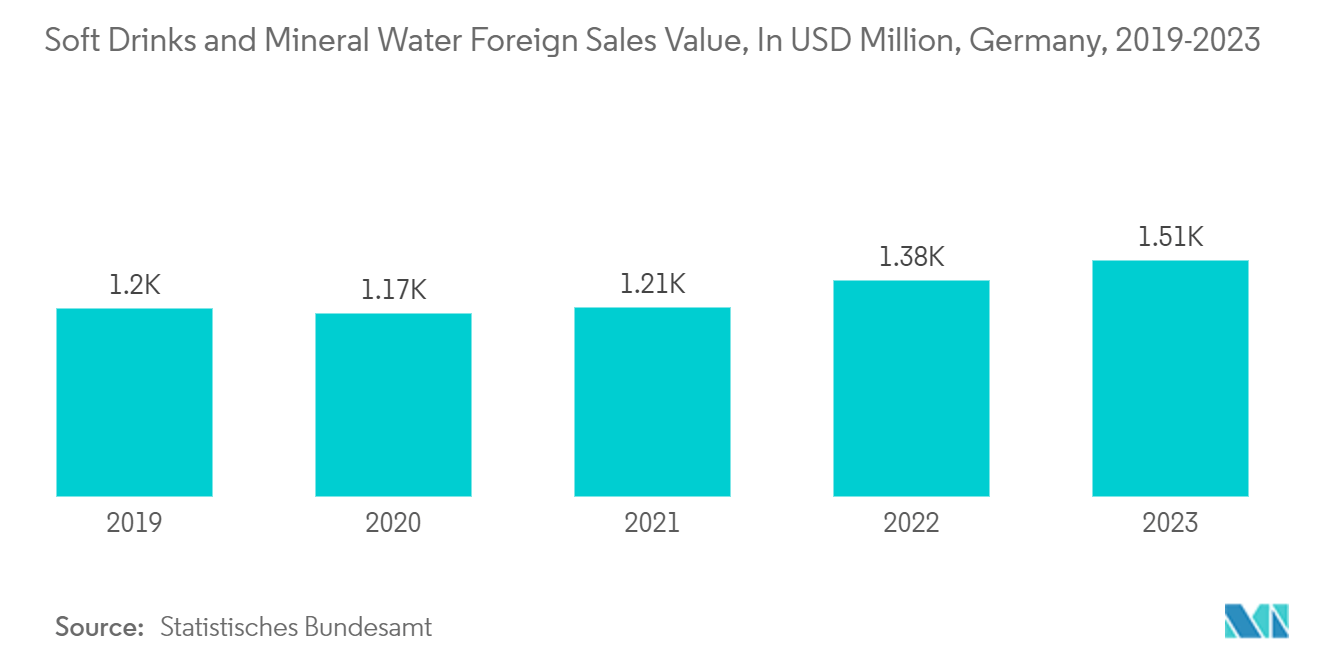
Germany Rigid Plastic Packaging Industry Overview
In Germany, the rigid plastic packaging sector is fragmented, spearheaded by prominent domestic entities like Frapak Packaging, Pinard Beauty Packs, and AST Kunststoffverarbeitung GmbH alongside global players such as Amcor Group GmbH and Aptar Group. These frontrunners actively pursue strategies like mergers, acquisitions, and product launches to fortify their foothold in the region.
- August 2024: In Germany, Alpla, a specialist in packaging and recycling, partnered with Sea Me, a provider of reusable packaging infrastructure, to introduce reusable PET bottles tailored for cosmetics and personal care products. These recyclable bottles, part of Sea Me's Zerooo system, are available in three colors and are compatible with all caps. Each bottle boasts a distinctive feature: a laser-engraved 2D data matrix code, known as the Zerooo ID, which offers insights into the bottle's contents and circulation history.
- November 2023: German water bottle company Air Up teamed with specialty materials firm Eastman to launch a fresh line of reusable bottles. Targeted at the European market, this new range utilizes Eastman's Tritan Renew material, boasting 50% certified recycled content, leveraging Eastman's advanced molecular recycling technology. This innovative technology deconstructs hard-to-recycle plastics into their fundamental molecular components, enabling their repurposing into new polymers.
Germany Rigid Plastic Packaging Market Leaders
-
Amcor Group Gmbh
-
Berry Global Inc.
-
Aptar Group Inc.
-
Alpla Group
-
Berlin Packaging
*Disclaimer: Major Players sorted in no particular order
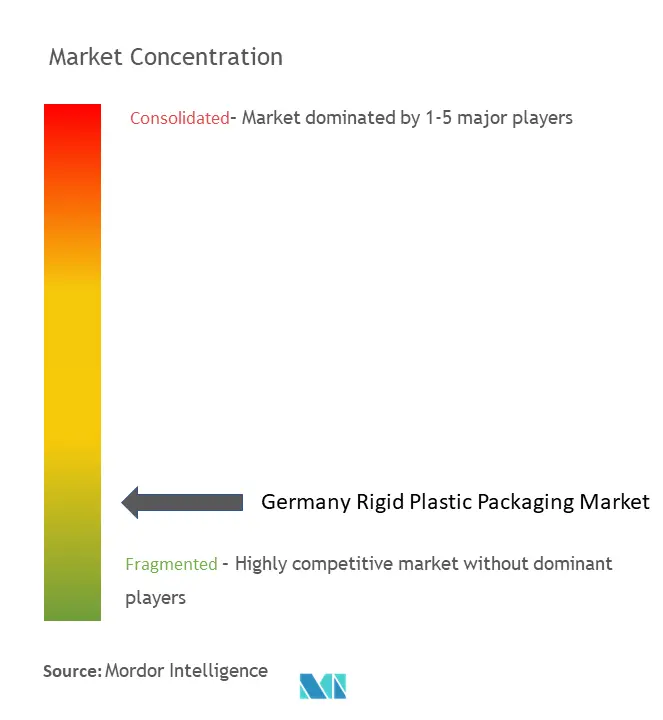
Germany Rigid Plastic Packaging Market News
- June 2024: Alpla Group, a packaging producer and recycler headquartered in Austria, has taken over Heinlein Plastik-Technik. Heinlein, situated in Ansbach, Germany, specializes in manufacturing closure systems, dosing systems, and application aids tailored for the pharmaceutical and medical sectors. The facility encompasses development and construction, featuring the company's proprietary mold construction and mechanical engineering. It also houses production, molding, and assembly operations.
- January 2024: IFCO, based in Munich, Germany, specializes in reusable packaging containers (RPCs). The company unveiled 'Dora,' an innovative reusable Plastic Pallet set to debut across Europe. Tailored for RPC compatibility and distributed via IFCO’s circular pooling model, Dora integrates effortlessly into the current fresh grocery supply chain. This integration enhanced logistics efficiency and sustainability benefits for both suppliers and retailers in the long run.
Germany Rigid Plastic Packaging Market Report - Table of Contents
1. INTRODUCTION
- 1.1 Study Assumptions and Market Definition
- 1.2 Scope of the Study
2. RESEARCH METHODOLOGY
3. EXECUTIVE SUMMARY
4. MARKET INSIGHTS
- 4.1 Market Overview
- 4.2 Industry Value Chain Analysis
- 4.3 Industry Regulations and Policies
-
4.4 Industry Attractiveness - Porter's Five Forces Analysis
- 4.4.1 Bargaining Power of Suppliers
- 4.4.2 Bargaining Power of Consumers
- 4.4.3 Threat of New Entrants
- 4.4.4 Intensity of Competitive Rivalry
- 4.4.5 Threat of Substitutes
- 4.5 Current Trade Scenario - Import and Export Analysis
5. MARKET DYNAMICS
-
5.1 Market Drivers
- 5.1.1 Growing Adoption in Food and Beverage Sector
- 5.1.2 Increasing Rigid Plastic Packaging Solutions Demand Across the Industrial Sector
-
5.2 Market Challenges
- 5.2.1 Price Volatility of Raw Material
- 5.2.2 Rising Competition From Flexible Packaging Products
- 5.3 Coverage on the Emerging Alternatives to Rigid Plastic and Their Current Demand
- 5.4 Assessment of End-user Buying Patterns and Key Influencers
6. MARKET SEGMENTATION
-
6.1 By Product
- 6.1.1 Bottles and Jars
- 6.1.2 Trays and Containers
- 6.1.3 Caps and Closures
- 6.1.4 Intermediate Bulk Containers (IBCs)
- 6.1.5 Drums
- 6.1.6 Pallets
- 6.1.7 Other Product Types (Blisters and Clamshell Packs, Rigid Plastic Tubes, and Pails, Among Others)
-
6.2 By Material
- 6.2.1 Polyethylene (PE)
- 6.2.1.1 LDPE & LLDPE
- 6.2.1.2 HDPE
- 6.2.2 Polyethylene terephthalate (PET)
- 6.2.3 Polypropylene (PP)
- 6.2.4 Polystyrene (PS) and Expanded polystyrene (EPS)
- 6.2.5 Polyvinyl chloride (PVC)
- 6.2.6 Other Rigid Plastic Packaging Materials (Bioplastics, Polyamide (PA), Polycarbonate (PC), and Ethylene vinyl alcohol (EVOH), Among Others)
-
6.3 By End-use Industry
- 6.3.1 Food
- 6.3.1.1 Candy and Confectionery
- 6.3.1.2 Frozen Foods
- 6.3.1.3 Fresh Produce
- 6.3.1.4 Dairy Products
- 6.3.1.5 Dry Foods
- 6.3.1.6 Meat, Poultry, and Seafood
- 6.3.1.7 Pet Food
- 6.3.1.8 Other Food Products (Seasonings and Spices, Spreadables, Sauces, Condiments, etc.)
- 6.3.2 Foodservice
- 6.3.2.1 Quick Service Restaurants (QSRs)
- 6.3.2.2 Full-Service Restaurants (FSRs)
- 6.3.2.3 Coffee and Snack Outlets
- 6.3.2.4 Retail Establishments
- 6.3.2.5 Institutional
- 6.3.2.6 Hospitality
- 6.3.2.7 Other Foodservice End Uses
- 6.3.3 Beverage
- 6.3.4 Healthcare
- 6.3.5 Cosmetics and Personal Care
- 6.3.6 Industrial (Chemical, Agriculture, and Oil and Lubricants)
- 6.3.7 Building and Construction
- 6.3.8 Automotive
- 6.3.9 Other End-use Industries (Household Products, and Logistics)
7. COMPETITIVE LANDSCAPE
-
7.1 Company Profiles*
- 7.1.1 Amcor Group Gmbh
- 7.1.2 Berry Global Inc.
- 7.1.3 Aptar Group Inc.
- 7.1.4 Alpla Group
- 7.1.5 Frapak Packaging
- 7.1.6 Retal Group
- 7.1.7 Mauser Packaging Solutions
- 7.1.8 Berlin Packaging
- 7.1.9 Pinard Beauty Pack
- 7.1.10 Schutz GmbH & Co. KGaA
- 7.1.11 AST Kunststoffverarbeitung GmbH
- 7.2 Heat Map Analysis
- 7.3 Competitor Analysis - Emerging Vs. Established Players
8. RECYCLING and SUSTAINABILITY LANDSCAPE
9. FUTURE OF THE MARKET
** Subject To AvailablityGermany Rigid Plastic Packaging Industry Segmentation
The rigid plastic packaging market encompasses packaging materials that retain their shape and structure without elastic deformation and exhibit only perfect plastic deformation. The scope of the study characterizes the rigid plastic packaging market based on the raw materials of the product, including PP, PE, PET, and other raw materials used across various end-user industries, such as food, pharmaceuticals, beverages, cosmetics, toiletries, and more across the country. The research also examines underlying growth influencers and significant industry vendors, all of which help to support market estimates and growth rates throughout the anticipated period. The market estimates and projections are based on the base year factors and arrived at top-down and bottom-up approaches.
The German rigid plastic packaging market is segmented by product type (bottles and jars, trays and containers, caps and closures, intermediate bulk containers (IBCs), drums, pallets and other product types), material type (polyethylene (PE) (LDPE, LLDPE and HDPE), polyethylene terephthalate (PET), polypropylene (PP), polystyrene (PS), expanded polystyrene (EPS), polyvinyl chloride (PVC), and other rigid plastic packaging materials), and end-use industries (food (candy and confectionary, frozen foods, fresh produce, dairy products, dry foods, meat, poultry and seafood, pet food and other food products), foodservice (quick service restaurants, full service restaurants, coffee and snack outlets, retail establishments, institutional, hospitality and other foodservice end users), beverage, healthcare, cosmetics and personal care, industrial (chemical, agriculture, and oil and lubricants), building and construction, automotive and other end-use industries (household products, and logistics)). The market sizing and forecasts are provided in terms of volume (tons) for all the above segments.
| By Product | Bottles and Jars | |
| Trays and Containers | ||
| Caps and Closures | ||
| Intermediate Bulk Containers (IBCs) | ||
| Drums | ||
| Pallets | ||
| Other Product Types (Blisters and Clamshell Packs, Rigid Plastic Tubes, and Pails, Among Others) | ||
| By Material | Polyethylene (PE) | LDPE & LLDPE |
| HDPE | ||
| By Material | Polyethylene terephthalate (PET) | |
| Polypropylene (PP) | ||
| Polystyrene (PS) and Expanded polystyrene (EPS) | ||
| Polyvinyl chloride (PVC) | ||
| Other Rigid Plastic Packaging Materials (Bioplastics, Polyamide (PA), Polycarbonate (PC), and Ethylene vinyl alcohol (EVOH), Among Others) | ||
| By End-use Industry | Food | Candy and Confectionery |
| Frozen Foods | ||
| Fresh Produce | ||
| Dairy Products | ||
| Dry Foods | ||
| Meat, Poultry, and Seafood | ||
| Pet Food | ||
| Other Food Products (Seasonings and Spices, Spreadables, Sauces, Condiments, etc.) | ||
| By End-use Industry | Foodservice | Quick Service Restaurants (QSRs) |
| Full-Service Restaurants (FSRs) | ||
| Coffee and Snack Outlets | ||
| Retail Establishments | ||
| Institutional | ||
| Hospitality | ||
| Other Foodservice End Uses | ||
| By End-use Industry | Beverage | |
| Healthcare | ||
| Cosmetics and Personal Care | ||
| Industrial (Chemical, Agriculture, and Oil and Lubricants) | ||
| Building and Construction | ||
| Automotive | ||
| Other End-use Industries (Household Products, and Logistics) |
Germany Rigid Plastic Packaging Market Research FAQs
How big is the Germany Rigid Plastic Packaging Market?
The Germany Rigid Plastic Packaging Market size is expected to reach 3.74 million metric tons in 2024 and grow at a CAGR of 1.47% to reach 4.02 million metric tons by 2029.
What is the current Germany Rigid Plastic Packaging Market size?
In 2024, the Germany Rigid Plastic Packaging Market size is expected to reach 3.74 million metric tons.
Who are the key players in Germany Rigid Plastic Packaging Market?
Amcor Group Gmbh, Berry Global Inc., Aptar Group Inc., Alpla Group and Berlin Packaging are the major companies operating in the Germany Rigid Plastic Packaging Market.
What years does this Germany Rigid Plastic Packaging Market cover, and what was the market size in 2023?
In 2023, the Germany Rigid Plastic Packaging Market size was estimated at 3.69 million metric tons. The report covers the Germany Rigid Plastic Packaging Market historical market size for years: 2019, 2020, 2021, 2022 and 2023. The report also forecasts the Germany Rigid Plastic Packaging Market size for years: 2024, 2025, 2026, 2027, 2028 and 2029.
Germany Rigid Plastic Packaging Industry Report
Statistics for the 2024 Germany Rigid Plastic Packaging market share, size and revenue growth rate, created by Mordor Intelligence™ Industry Reports. Germany Rigid Plastic Packaging analysis includes a market forecast outlook for 2024 to (2024to2029 and historical overview. Get a sample of this industry analysis as a free report PDF download.



